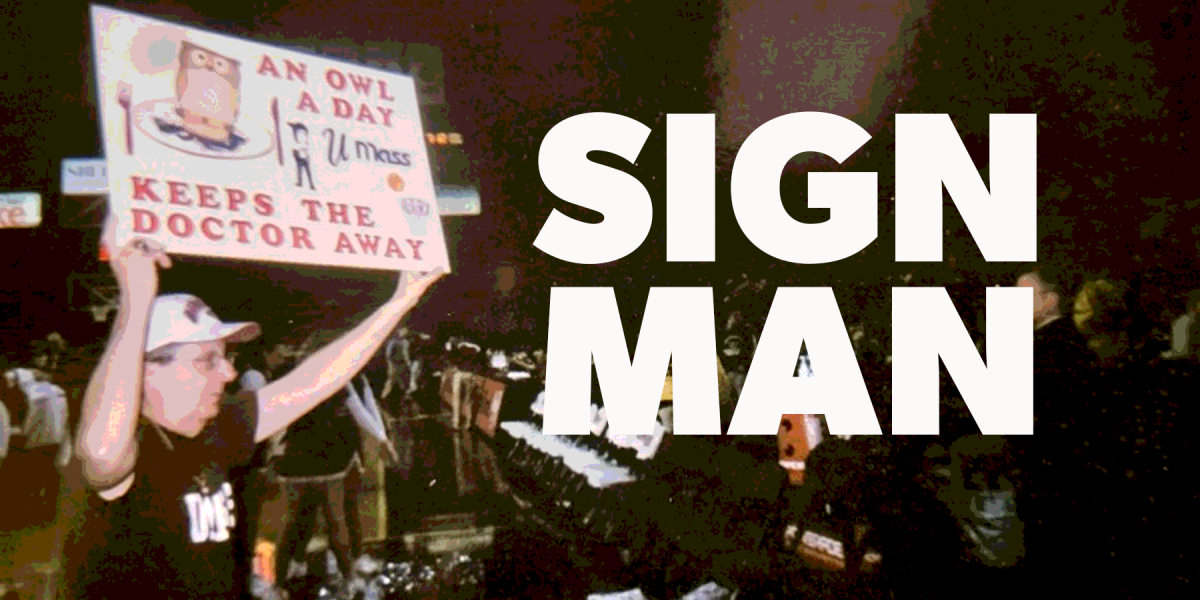
Sheena Arabesque confidently works her way across the Diva’s Nightclub stage in Northampton, sensually pandering to the crowd as a handpicked club beat blares from the speakers.
Her routine is captivating – one second she’s grinding against a speaker support, the next she’s plucking a dollar bill from the mouth of a fan standing in the front row.
For nearly four and a half minutes, her voluminous, curly blonde hair struggles to keep up with the rest of her body as she dances. She wears only a black fringe bra and harem pants.
Her performance is provocative, fun and energetic. This is her moment, and she owns it, coming in first place in the competition at the end of the night.
But it’s not who she is.
Finding a niche
If you ask Graham Stanley, he’ll tell you he doesn’t have many talents. But he’s found his niche.
“I can’t draw, I can’t sing, I can’t act,” he said. “But I can lip sync and I can dress up and look good.”
A 21-year-old University of Massachusetts student and Leominster native, Stanley competes as a drag queen multiple times a month. He travels across Massachusetts to perform in various venues, driving as far as Lowell to take part in a monthly show.
In those circles, he’s known not as Graham Stanley but by his stage name, Sheena Arabesque.
“I don’t think I’m a natural performer, so it’s taken me a while to get to where I am now,” he said.
Stanley started performing four years ago, even competing in an online drag competition on the microblogging website Tumblr. He learned almost everything he knows, from how to apply makeup to performance techniques, from his “drag mother,” Nikita LeFemme, in Worcester.
His stage name was originally Sheena LeFemme in homage to her, but he eventually decided to create his own unique character.
“It was a big thing for me to create my own self that I could put Graham into,” he said.
“Sheena” is a character in a video game, “Tales of Symphonia.”
“She and I share a lot of similarities … she’s a little shy, awkward, sometimes clumsy, lacking in self-confidence, but when push comes to shove she is a strong character,” Stanley said.
His last name, “Arabesque,” is a French word.
“The idea of it is taking hard shapes and making something beautiful out of them,” Stanley said. “I think that’s kind of what we’re doing. We’re playing with the geometry of our face and making things soft and beautiful, or if you want to go with the hard drag, edgy.”
That transformation process can take anywhere from one to two hours, as Stanley applies multiple layers of makeup and false eyelashes, picks out clothing and sometimes a wig, and prepares for his performance by singing and dancing in the mirror.
And when he finally gets on stage, Stanley said, “It’s a rush. I don’t even hear the audience cheering at all because I’m so focused. It’s just so much fun to get up there and lip sync and dance around, and people give you money which is always nice.”
‘The physical is so changeable’
Drag means something different for everyone who does it. For some, it’s a way of life, but for others, like Stanley, it’s more of a hobby.
“For me it’s more performative than identity, it’s just a fun way to entertain,” he said.
Stanley first dressed in drag in the eighth grade, wearing his mom’s shirt, a skirt, fishnets and an iParty wig for Halloween. But it was “RuPaul’s Drag Race” – a reality television series about the search for America’s next drag superstar – that really opened Stanley’s eyes to what could be done with drag.
“I didn’t think that I would ever be able to because I’m not the type to be good at things or whatever,” he said. “I just didn’t have the confidence to try it.”
Then, for his high school senior project, Stanley decided to explore gender stereotypes in Western civilization through the lens of drag.
“That’s what kind of got me started,” he said. That was four years ago, and he’s been performing consistently since.
“It’s very physically transformative, and there’s an inner transformative aspect to it, as well,” Stanley said. “It’s definitely brought me out of my own shell.”
In kindergarten, Stanley was diagnosed with psoriasis, a condition which makes his skin produce too much of itself, creating red, flakey patches on his body.
“As kids grew up and we got older, kids got smarter, kids got meaner,” he said. “I was told in like middle school that I was worthless, that I shouldn’t be alive because I was so disgusting. Kids would run away from me in the halls.”
Drag, he said, has been instrumental in helping him gain self-confidence.
“The physical is so changeable,” he said. “Even if (the psoriasis) itself can’t be cured, I can do so much to change what I look like that the physical doesn’t matter.”
“By changing the outer shell, it’s really helped me come to terms with my inner self, and I do have worth, I am worth so much.”
‘See how it affects you’
On the night of his performance at Diva’s, Stanley picks up his friend Lior on the way to the nightclub. The two spend a couple of hours before the show chatting, dancing and taking selfies.
“My friends all love it. They think it’s the coolest thing and I’m so glad about that,” Stanley said. “They meet me and I’m like this dude and then I’m like, ‘I’m a drag queen.’”
“You don’t meet drag queens every day,” he added.
And when it comes to his family, Stanley said he’s been lucky, especially when he came out as gay at 14.
“I’ve had no issues in school with that or with my family or anyone,” he said.
“With the drag thing, my mom is very supportive,” Stanley continued. “She’s been to a few of my shows and she always says, ‘Send me a picture of your face when you’re ready, I want to see what you look like,’ which is really cool.”
Stanley said his dad “doesn’t get it,” but is still proud Stanley has found a hobby he loves.
“I’ve been very lucky, but I know there are many people who have to like hide all their stuff and only do their face at night and sneak out just to be able to do it,” he said.
“And it’s really sad that it has to be that way because you know there’s so much art in it and so much creativity that people don’t understand. And to limit it that way, it’s just heartbreaking.”
As a novice drag performer, Stanley struggled to differentiate his appearance from how he identified on a daily basis.
“I felt like my actions were more masculine than normal because I was looking so feminine,” he said. “It was just a weird balancing act of how do I feel given who I am, which is a fun way to explore the ideas of gender and sexuality and character and what a man is, what a women is, and how that divider shouldn’t be so concrete,” Stanley said.
“I think if you want to question gender, just get in drag some time and just see what it feels like. Look yourself in the mirror and talk in your own voice, and then try to talk in a lower voice or a higher voice, and just see what that does to your mind. See how it affects you.”
Aviva Luttrell can be reached at [email protected] and followed on Twitter @AvivaLuttrell.



















Allison M. • Oct 19, 2014 at 12:05 pm
What a fantastic profile. I’m so in awe of Sheena and how she overcomes her obstacles and gains self-confidence when performing. You go, gurl! 🙂
Zac Bears • Oct 15, 2014 at 12:21 pm
I know I already said it, but this is an absolutely fantastic story. I loved reading it, and I can’t wait to see Sheena perform!